|
|
 |
|
CLICK TO SEE TWO PARROTS TRY TO OUT-EAT ME
BEFORE COOKING...
As a general rule, add veggies to whatever you cook. If you're making
beef stroganoff--put peas in it. If you're making spaghetti sauce--put peas in it. Then, when you eat, you can pull
out the "healthy" peas to spoon-feed your bird. Spoon-feeding eliminates the risk that, if you let him do all of his
own picking, he might decide that the "less healthy" part tastes better than the veggies. I can't let Ziggy have unrestricted
access to my pinto beans anymore because once he discovered the taste of bacon, he wasn't satisfied with beans.
[I have to pick out the bacon first and hide it from him under the cornbread.] I had a similar problem because I usually
add blue cheese to my salads; I can't let Ziggy forage in the salad or the blue cheese will all disappear.
But in general, by choosing carefully, you and your bird can eat together, thereby satisfying your bird's social needs
without compromising his diet.
There are no laws that require vegetables
to have salt added or to be covered with sauces, and--shock!--birds like them straight. Frozen corn and corn
on the cob are delicious when cooked without anything added. The cooking channel makes me cringe because so many
chefs add so much salt to their dishes so thoughtlessly. I use the word "thoughtlessly" because they don't question
its presence; to them, that would be like questioning why we breathe air.
Some foods, like cheese, have to be handled
when Ziggy is not looking. His background gives him plenty of knowledge of foods (and what fast-food and potato chip sacks
have in them.) If he sees cheese going into a dish, he "knows" the dish is going to be good, but he will also start
crying for some cheese. On rare occasions, I have to use cheese as a bribe, for instance, to make him let
go of something I can't allow him to swallow, such as a button. I know, doing so rewards him for bad behavior,
but sometimes the potential of imminent harm outweighs other considerations. I also reward him for taking
a shower without incident; I promise him ahead of time that if he behaves I will give him a bite of cheese, and I keep my
word. (Buddy has the same aversion to showers and to being misted; what is the deal with these birds?) Until they
took it off the market, I would give him a tiny piece of Kraft® low-fat LiveActive® cheese because of the probiotic content.
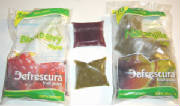
|
| FROZEN FRUIT PULPS |
| FRUIT COMPOTE |

|
| ONE BATCH LASTS FOR MONTHS |
THE BEST FRUIT SPREAD
Some parrot owners worry about giving their birds bread because of the
yeast in it, but according to Australian vet Dr. Harris, the yeast used in bread is harmless to birds. Most breads available
at the supermarket are worthless nutritionally, but some have value. Parrots are obviously going to prefer bread with
seeds added and a few of those breads are commercially available. Ziggy will sometimes actually ignore
whatever is spread on the bread, at least at first, so he can root out the baked-in or baked-on goodies. He seems to
like anything with millet, as well as more obvious goodies like sunflower seeds.
NOTE: BREAD, REGARDLESS OF HOW "HEALTHY" IT MAY SEEM, IS A COMMON "HIDDEN" SOURCE OF SODIUM, "HIDDEN" IN
THE SENSE THAT MOST PEOPLE DON'T CONSIDER ITS CONTRIBUTION TO THEIR SODIUM INTAKE. IF YOUR BIRD IS GOING TO "HELP" YOU
WITH YOUR BREAD, STUDY THE BREAD'S LABEL. GET THE BREAD LOWEST IN SODIUM, IN ADDITION TO MAKING SURE THAT IT'S WHOLE GRAIN.
One slice of Genesis 1:29 Sprouted Grain & Seed Bread has only 65 mg of sodium, but one slice of Pepperidge Farm Whole
Grain Double Fiber has 170 mg of sodium, while Roman Meal 100% Whole Wheat Sliced Bread has a phenomenal 200 mg of sodium
per slice. Milton's Healthy Whole Grain with Honey Bread has 125 mg of sodium per slice. Food processors sneak in as much
sodium as they can in order to trick your palate into "liking" a food: the point is, pay attention and read the label. One
other thing to consider is this: there's no law against making your own bread. The only problem with that is that almost all
bread-making machines have Teflon coatings, and you don't want to use any Teflon-coated equipment around your bird because
of the possibility of Teflon fumes causing PTFE toxicosis.
We used to eat Seeduction bagels and bread from Whole
Foods®, but I've been getting more particular these days about whole grains, and I realized that "Whole" Foods was
not always "Whole." I joke sometimes about Whole Foods as being the epicenter of the pseudoscience epidemic, but one
thing I like about them is that I don't have to worry about their foods containing trans-fats, which is hard to avoid if you
want to buy prepared food. Although Whole Foods may be particular about the quality of an item, i.e., in insuring that it's,
say, pesticide-free, the kind and quality of the fats they use, other than not containing trans-fats, don't seem to concern
them. At least your heart attacks will be "healthy" heart attacks, though. If you live near a WFM, check out their
prepared food section and ask yourself how much whole grain pasta or rice you see there: it's normally precious little. In
the case of WFM's Seeduction bread, I decided that the added seeds don't make up for the fact that the
flour, although untreated, is nevertheless not whole grain.
White bread is still not much better than toilet paper.☺
A sprouted grain with seeds bread, called Genesis 1:29®, from
Foods for Life®, is available in the frozen section of most health food stores and some large supermarkets, such as Kroger. It's
much healthier.
When we're in Arkansas, we partake of a delicious fresh white whole-grain
seed mixture, "Woodstock," from Neighbor's Mill. And when we're in Houston, there's a bread that tops them all, the most delicious I have ever tasted, called "Dakota Bread,"
containing only "Freshly Stone Ground Whole Wheat Flour, Water, Pure Texas Honey, Pumpkin Seeds, Sunflower Seeds, Sesame Seeds,
Millet, Yeast, Salt." After tasting that, partly because of the honey, and partly because Stone Mill is not so stingy
about the seed "goodies," Ziggy won't even touch either of the other breads if offered at the same time. (See http://www.stonemillbakers.com/.)
Instead of butter
and jelly, I demand a healthy table spread; I used to use Smart Balance's Omega Plus® for some time, but lately I've switched
to an Earth Balance® product, "natural buttery spread," because I like the oil mixture they use better, and because
it contains no soybean oil. I use the healthiest fruit spread there is--one I make myself.
I know it will come as a shock to many people, but there is no law requiring
that butter or margarine be spread on bread or toast. It will probably come as a further shock that bread can actually
taste good without any table spread. The best compromise is to use Earth Balance® or Smart Balance®. If Ziggy
sees any tell-tale yellow blobs on the bread or bagel, he'll immediately try to root it out--he knows what's good!--so I always
warm it after buttering. I "enrich" the Smart Balance first, though: I take a 15 ounce tub of it, let it soften, then put
in a capsule of vitamin K2 complex, a zeaxanthin capsule, several capsules of a softgel version of milk thistle complex,
some CoQ, and a couple of other things. The 15 ounces contains about 96 teaspoons, and one slice of bread will get less
than one teaspoon; if a bird gets even as much as 1/20 of a slice of bread, and were to eat all the Smart Balance on that
part of the slice, the total amount from those capsules in that amount of bread that would get consumed would be less than
1/20 x 1/96, or about .05% of what's in one capsule, so I have no concerns about the enrichment.
After years of experimenting, I have finally gotten a recipe for a fruit
spread, or compote, that is healthy for both of us as well as delicious.
My recipe is constantly being revised, but
here is the most recent version: start with 2.5 lbs. of dried Chinese wolfberries (also called goji berries.)
Even if you get premium grade, manicure the berries--a few may have molded during the drying process; you don't know.
Rinse the berries quickly with boiling water, and then reconstitute them with water. Then, puree most of the wolfberries,
but leave a few free berries for your bird to pick out. Wolfberries are on a par nutrition-wise with bee pollen,
and are used in traditional Chinese medicine (TCM) as a tonic.
Add 2 pounds of roughly pureed, peeled prickly pear fruits (called tunas).
Make sure to get the purple tunas; the white ones are sweet also, but the purple ones are healthier. I buy them in season
and freeze several pounds to use throughout the year. Warning: if are picky, or if you are making it for human
consumption only, you might consider straining the puree to remove the seeds, but I don't mind seeds and Ziggy loves
them.
Now, add 3 pounds of frozen blueberries and a pound each of unsweetened
frozen fruit pulp--mora [blackberry], lulo [naranjilla], and maracuya [passion fruit]. Lately, I've been increasing
the amounts of mora. Because the unsweetened fruit pulps are often lacking enough sweetness, I'll add a twelve ounce
package of frozen juice concentrate, such as the pomegranate blueberry blend made by Old Orchard®, along with
whatever amount of currently available Naked® juice smoothie is necessary to adjust the sweetness of the mixture.
Make sure to bring this to a boil.
To make it even more nutritious, I add micronutrients, such as biotin,
tocotrienols, lysine, methionine, taurine, silymarin, pomegranate extract and a little lecithin. Putting
MINUTE AMOUNTS, such as a capsule or two, into a gallon or two of mixture is not going to create a "megadose." (Ziggy
has had fatty liver disease since before 1996, so milk thistle extract gets put into almost everything we eat.)
I also add a few diced serrano or habanero peppers for flavor, but not enough to make it "hot." This results in
about 2 gallons of delicious, nutritious fruit compote.
WARNING: I emphasize the extreme
dilution involved in adding a capsule or two of something to two gallons of food because you may end up having issues
with your vet. Vets are no different than doctors in the sense that, with many, just mention herbs or supplements and
their minds are going to stop working. They will start thinking hypervitaminosis, which is a genuine concern; vitamins
A and D, in particular, can be toxic. And, just like doctors, some vets are likely to warn you, on the one hand, that
herbs are so powerful that they can kill or injure your bird, but, on the other hand, the vet will not admit that an
herb could be powerful enough to cause healing. Intellectual blindness causes some to be incapable of perceiving the
logical inconsistency in those two beliefs. Doctors will preach to you all day about how diet can cause or aggravate
sickness, but only a few will suggest that the opposite might be true.
In addition, using the one word "alternative" to describe all such practices is a categorization that
makes it difficult for many minds to rationally examine the genres of "alternative" separately. Some are obviously
valid, some pure quackery. I suspect that some medical and veterinary schools skimp on training in this regard.
A couple of years ago, I saw a new MD who, when I mentioned that I had been taking a certain herb, completely dismissed the
idea that it could have any physiological effects because she thought that it was homeopathic (although, in a bizarre
twist, she later decided to blame certain symptoms on that herb.) Another instance is that of a veterinary
website where the vet's information was wrong; the vet dismissed the idea of using probiotics as a supplemental treatment
for yeast infections in birds because he thought that probiotics were homeopathic. In both cases, I theorize that
the errors arose out of the way they were trained.
There is no shortage of quackery in this world, and I have to admit that it would be difficult even
for me to pay attention to what somebody is saying if they advocate anything ridiculous like homeopathy or "altered"
water or healing magnets. There is a lack of understanding of science concurrent with a lack of analytical thinking
skills among many people, part of the blame for which falls on our public school systems. In the cases of the vet and
the MD I mentioned, they both knew that homeopathy is quackery, but neither one of them obviously knew what it was, else
they would not have confused other, valid treatments as homeopathic.
Back to the fruit compote; let me emphasize the importance
of taking the whole mixture to a rolling boil: the frozen fruits, pulps, and especially the wolfberries are not
sterile, and I like to start off with a clean slate--no microorganisms. Just to be safe, I add a few drops of grapefruit
seed extract to the mix after it has cooled. I don't go to the trouble of converting the mixture into a jelly proper,
but if you want to, add the appropriate amount of low-sugar pectin and follow the package directions to make a jelly; you
might have to add lemon juice to get it to gel.
The problem with making it into a jelly is that you have to boil
the mixture longer; such heating does degrade the nutritional value of the mixture. My process is not intended
for standard canning; I freeze the compote in mason jars and thaw individual jars as needed.
If you consume it every day, as we do, each jar will be emptied
in no time. What keeps regular jams and jellies from getting moldy is their high sugar content; since our
compote has no added sugar, it must be kept refrigerated, and used reasonably quickly. I have never had any get moldy,
but since we eat it so fast, I don't have the slightest idea of what the actual shelf life is.
| BREAKFAST BAGEL WITH MY SPECIAL COMPOTE |
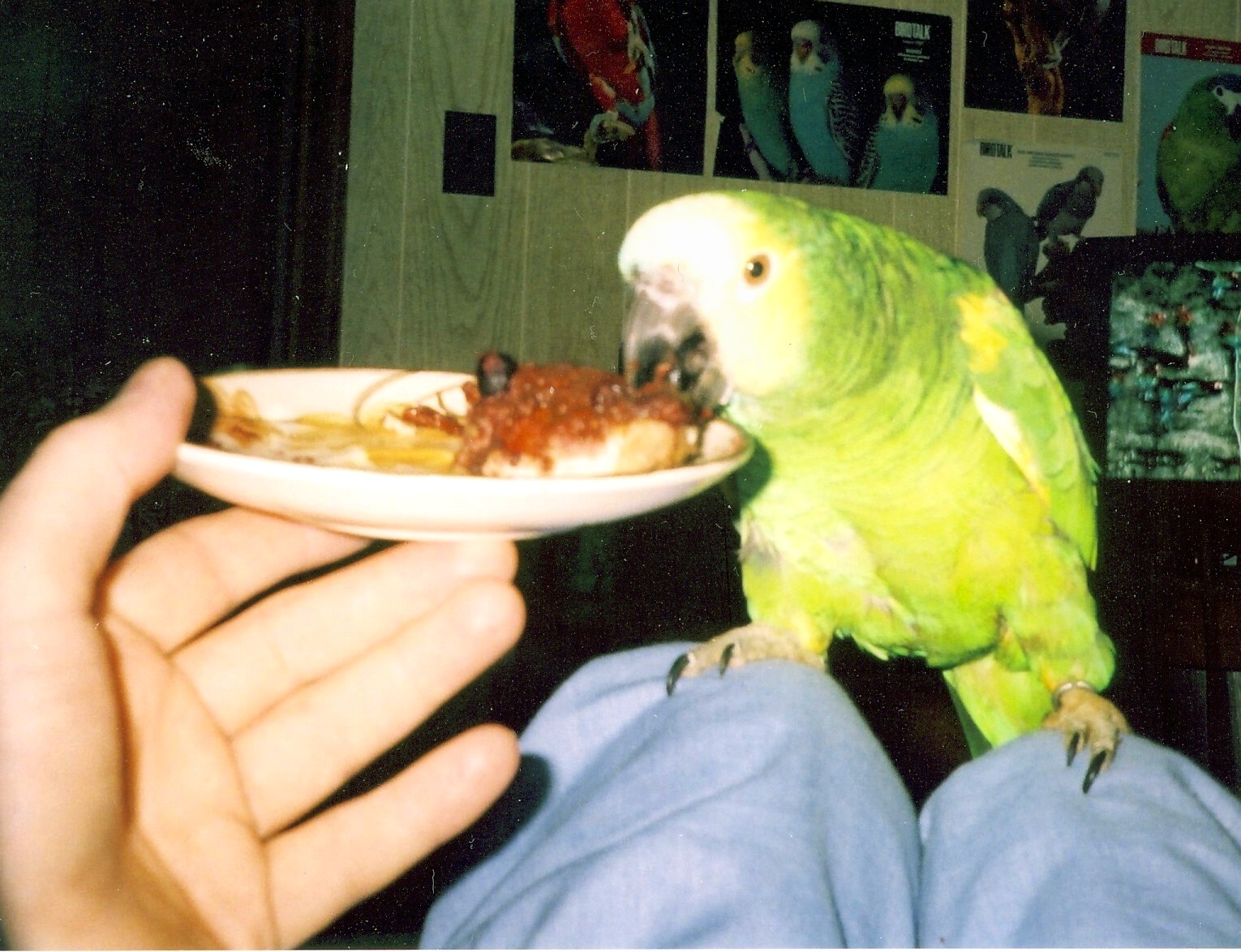
|
| ZIGGY GETS HIS SHARE |
HE LIKES FRUIT
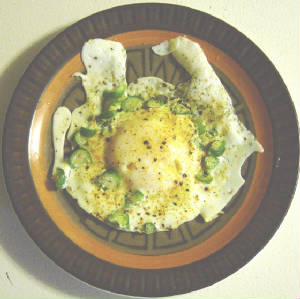
WHY
EAT EGGS? AREN'T THEY BAD FOR YOU?
Before Ziggy, I only ate eggs once
a month or so. Eggs were considered heart-unhealthy by the medical profession for a long time, and some doctors still
feel that way. Since heart disease runs in my family, I had eliminated table salt and most eggs from my diet in the
1970's. As I describe on our home page, Ziggy told me what he wanted one day ("Yum yum good egg"), so I started eating more eggs--when the master speaks,
you have to obey!

Parrots love eggs. But are they bad for birds to eat, as so many
people think? Considering where birds come from, it's hard to imagine how they could be, but we've all heard over the years
about how "bad" eggs are supposed to be for us because of saturated fat. Contrary to the hype we've grown up with, eggs,
especially the yolks, are nutritional powerhouses, containing lecithin, vitamins E and A, and numerous other micronutrients.
I buy only the healthy kind--the ones with high levels of omega 3 fatty acids (high-EPA eggs) and high levels of lutein
as well. Yes, there is some saturated fat in the yolks, but small amount of cholesterol can easily
be dealt with by making proper additional dietary choices.
Some vets still warn us that, because our birds are as long-lived as
us and develop atherosclerosis also, we have to avoid giving them eggs because of the cholesterol content. Yet, if you
look in your pet catalogs, you will see a number of egg-containing products, such as Quiko® Egg Foods, so not all bird professionals
agree with the egg alarmists.
Let's assume that eggs are cooked in a healthy manner, that is,
some way other than being fried in bacon grease, butter or traditional margarine, so that there are no unhealthy non-egg ingredients.
Let's look at the eggs themselves.
The fact is that the fat is in the yolk, not the white.
Ziggy won't touch the yolk anyway, unless it's part of
an omelet. We do have omelets (see below), but the egg in my omelets is more of a binder than a main constituent.
There is one drawback to letting your bird eat egg white, a drawback which, because of so
much concern about the fat in the yolk, gets overlooked. Egg white is almost all protein, and a high protein
diet IS bad for your bird's kidneys. In that sense, then, egg white is "bad." But a few bites
of egg white, as a treat, are not going to kill your bird or cause kidney disease. What is important to consider
is the percentage of protein that ends up in the crop, i.e., the mix that ends up being digested.
In early 2012, I had to do away with even the few bites of egg white
Ziggy has been getting because his liver disease flared up; the vet prescribed lactulose to reduce the ammonia load in
the gut, and said he wasn't to be allowed any meat or other high protein foods, which really complicated eating because of
having to hide more from him.
| TWO BRANDS OF HEALTHY EGGS |
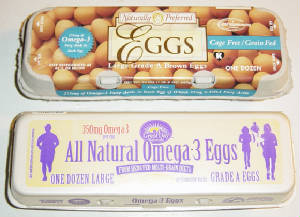
|
| EGGLAND'S BEST ARE ALSO GOOD |
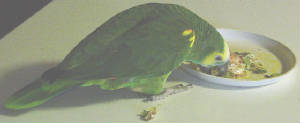
|
| TURN YOUR BACK ON YOUR PLATE, AND GUESS WHO'LL HELP HIMSELF.... |
When we do have fried eggs, they are the LAST course of
the meal. I make sure Ziggy has already eaten plenty: the eggs have to be a surprise because if he knows that fried
egg is on the menu, he won't eat anything else until the egg comes.
I fry them sunny-side up in a stainless steel pan over VERY low heat. I spray the pan
first with a lecithin-based cooking spray, then sprinkle some Butter Buds®, some fresh ground black pepper and some milk thistle
extract on top of the egg. If I am very careful, the whites are perfectly done, even on top, and the yolks are still
runny. This is best done on a gas stove because of the heat control required. For an extremely exquisite
flavor, a touch of truffle-flavored olive oil can be added afterward.
If I'm in a hurry, I'll fry the old fashioned way, but I use a mix of rice bran oil, walnut oil, and organic red palm
oil in a small cast iron skillet, allowing a little diced habanero to begin to sizzle before adding the egg. I don't
allow Teflon® or any other modern non-stick substance in my house because of Ziggy. I don't trust myself not to accidentally
leave a burner on, and if there is no Teflon in the house, there is zero possibility of endangering Ziggy with fumes from
overheated Teflon.
Properly seasoned, a cast iron skillet is virtually non-stick,
and if it gets overheated, the fumes are not toxic to birds like Teflon fumes. If the skillet is seasoned properly, the
iron is not in direct contact with the food, so you don't have to worry about iron leaching into the food. Cooking with
unseasoned or freshly seasoned new cast iron will cause a dramatic increase in the iron content of the cooked food, especially
if you cook acidic foods; see this nutritionist's blog for a discussion. [When I use the phrase "properly seasoned," I mean a skillet that has gone through literally dozens
of applications of the fat/heating cycles necessary to produce a black non-stick surface. Cook's Illustrated has reported
that cooking acidic food too long even in a well-seasoned pan will result in the food acquiring off-flavors, which implies
that acidity plus heat will start disintegrating the black finish. I doubt that any researchers have used skillets
as well seasoned as mine to test iron leaching.]
|
 |
|
ZIG SAYS HELLO
| BAKED OMELET WITH PEAS AND POTATO |
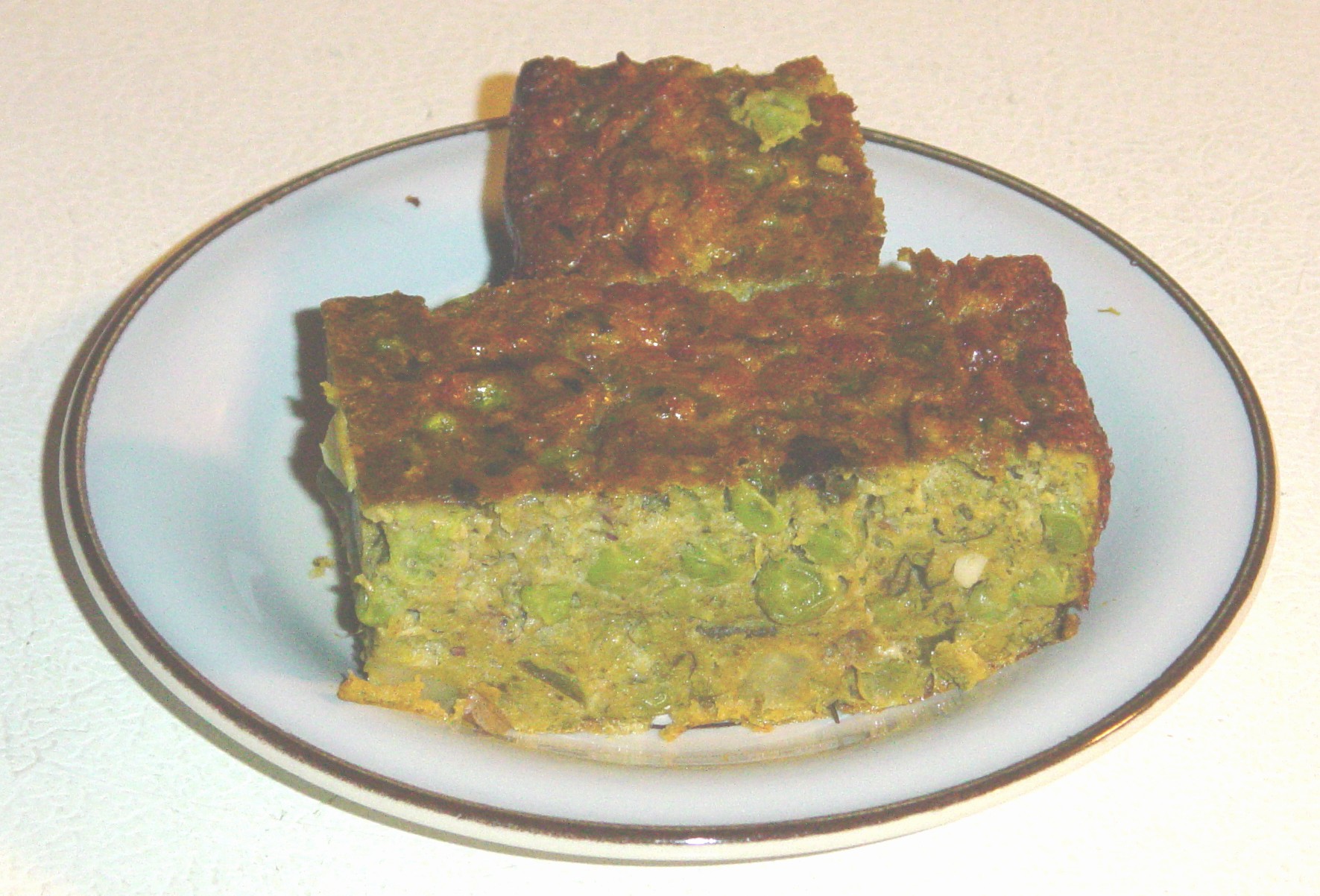
|
| ZIGGY WILL LICK THE PLATE WHEN IT'S ALL GONE |
OMELETS
I am not a gourmet cook. What I fix has to be fast, healthy, and easy to clean up. When
you have a major illness, you're lucky to have an appetite or be able to eat properly, let alone spend time in the kitchen,
so I've come up with a lot of shortcuts. I was looking for some healthy oils, and I discovered an oriental secret: black sesame oil. Toasted sesame oil is magic when added to eggs and casseroles.
It adds a bacon-like flavor and makes omelets taste almost like egg foo yung.
For an omelet,
microwave a potato ahead of time, then cut it into small pieces. Don't use frozen fries or frozen potato pieces
because almost all brands are loaded with salt and fat. Beat 2 or 3 high-EPA eggs with just a tablespoon of milk, lots
of diced serranos or habaneros, some powdered shitake mushroom, some milk thistle, a little lecithin, and a
few drops of black sesame oil. Do not add salt. Spray the pan with a lecithin cooking spray and cook on ultra-low
heat.
I usually put peas in the omelet; he'll pick those out first. I use fresh frozen peas,
rinsed first to remove the salt with which food makers inevitably try to poison us. After Ziggy picks out all of
"his" peas (and potatoes), he'll go crazy for the omelet itself (the more peppers in it, the more he likes it.) I am
such a good cook that he usually licks the plate!
For a more complicated omelet, I use 6 to 8 extra large eggs, and instead of milk, I use fruit juice or some
smoothie. If you're thinking about fortifying the mix, in this case do not add biotin. Although birds have a high
nutritional requirement for biotin, and you might want to add it to other things, the egg whites create a problem: a protein
in raw egg white, avidin, binds with biotin and makes it unavailable, so it would be pointless to add biotin.
Add other veggies to stretch the omelet. To make it more nutritious, add a couple of teaspoons of spirulina
and/or broken cell wall chlorella. For a hint of seafood flavor, add a couple of teaspoons of Lee's Extra Sauce. Made this way, there is no added sodium whatsoever except for whatever is in the Lee's Extra Sauce, which is only
140 mg per tablespoon, so what you end up with has less than 20 mg. of sodium per serving.
| OMELET |

|
| THIS IS MORE THAN A WEEK'S WORTH OF BREAKFAST |
COOKING HINT:
Shitake mushrooms are medicinal as well as culinary. I buy pound bags of dried shitakes at
oriental supermarkets and then grind them up a few at a time in my blender. The mushroom powder that results is an excellent
addition to any casserole or gravy. This way I get the mushroom flavor without the added salt of prepackaged mixes.
It's also much cheaper that way.
THE BEST SALMON FILLETS...
Costco and Sam's Club both carry Morey's® Seafood brand frozen,
marinated "wild Alaskan" salmon. A 2.25 pound package contains 6 individually wrapped fillets, with only 170 mg
of claimed sodium per 170 gm serving (it tastes saltier than that to me, though.) The cost is just over $2 per fillet.
They are delicious and easy to fix.
Use a
couple of serrano peppers for each fillet. Place the thawed fillets, skin side down, on a bed of the diced peppers
in a shallow dish. Make sure to squeeze all the marinade out of the packaging. You might add a teaspoon or two
of olive oil or walnut oil to the bed of chili peppers if you plan on using the drippings to season your potatoes or rice;
if not, the amount it comes with is enough for the salmon. Cover the cooking dish with plastic wrap, but vent it.
Cook for about twice as long as the package directions call for, but at half or slightly less than half of the suggested power
level.
Over the years, I have discovered that microwave
cooking is much more successful, especially for fish products, if you extend the cooking time but reduce the power level.
For example, if the label says 8 minutes at full power, use 15 minutes at power level 4 (if your microwave is stronger than
1000 watts.) Food makers know we all want speed and convenience, and their directions are intended for the impatient
among us. Your foods will cook much more evenly if you take my suggestion.
This
dish is best served with freshly microwaved red or purple potatoes. Butter the potatoes first with a little Smart
Balance. Since the marinade will all be rendered out of the fish by the cooking, you can then spoon the
marinade (with peppers) over the potatoes. The oil in the marinade absorbs the chili "heat" and creates
a smooth, satisfying warmth.
The delicious flavor of the Morey's product inspired me to try a
similar one, Bronzed Tilapia by Inland Market®, also decently low in sodium (a claimed 329 mg per 113 gm serving.) I
was sorely disappointed when I prepared it using the directions on the label: it didn't taste bad, but it didn't
taste good enough to give me even the slightest desire to ever eat it again. By spicing it up a little, however,
I was able to make it delicious. Bourbon was listed as an ingredient, so, knowing food makers, I figured that
they either didn't add enough, or else they didn't use a good enough brand, so I spiked it with a few tablespoons of
Jack Daniels®, and then added a couple of diced chili peppers and a little olive and grape seed oil, along
with a touch of Nasi Goreng seasoning (an Indonesian item). After marinating the fillets for a while, I then microwaved
them at power level 4 for 10 minutes. That made it a winner, although after reading about how bad farm-raised tilapia
is for you because of the poor quality of the lipids, I no longer buy any tilapia.
|
 |
|
|
|
 |
 |
 |
|
ZIGGY'S OPINION OF MY COOKING...

|
| OATMEAL, GRITS, TAPIOCA, PEAS |
BREAKFAST PORRIDGE:
Like all properly spoiled birds, Ziggy gets spoon-fed.
What we often have is a goo that is nutritionally similar to commercial pellets, with one important difference: it tastes
good. The starting point is a grain, preferably whole grain--oats are easy, so is instant brown rice, you can use any grain
or grain combination. Combinations are better so you end up with a more complimentary amino acid mix. I cook several
days worth at a time, and freeze most of it for later.
Kasha (buckwheat) is a good grain to include
because it's firmer and nut-like in flavor. Uncommon strains of rice are usually more flavorful also. I prefer purple
rice, not just because of the flavor, but because the chemicals in the rice responsible for its purple color probably
have similar antioxidant properties to those of colored berries. I would like to see an epidemiological study to
find out if there are any health benefits associated with consumption of such rice. Whole Foods has the colored rice
as a bin item; Oriental supermarkets carry it from various vendors, such as "Wild Sweet Rice" from Wang Foods (upc 0
87703 00907 3.)
You can add tapioca granules to improve flavor and cut down on the percentage
of protein. (I said granules, NOT prepackaged pudding.) You have to do a water soak before cooking if you are going
to use raw tapioca or kasha. Tapioca is an unusually "empty" starch, though, so I don't recommend it.
When you're ready to cook, add some chopped serrano chilies;
if you're out of chilies, add some General Tso's pepper oil instead, but remember that it contains salt. Since
grains are usually low in the amino acid lysine, I always add lysine powder, as well as milk thistle extract, biotin,
and a couple of hundred milligrams each of taurine and methionine (you'll find that commercial bird products are
usually enriched in those substances.) If you are making a large enough volume, you
might consider adding other micronutrients, such as tocotrienols or various polyphenols (such as grapeseed extract) from capsules
of human supplements. It is important to ensure that
what you end up with will not be excessive as far as dosage is concerned. You don't want to poison your bird with vitamins
or other supplements. You want only biologically plausible amounts of any such substances, unless you have good evidence to
indicate otherwise. Do what I did: make "caution" virtually my middle name. You don't
have to add an entire capsule's worth into the mix; use common sense--the amount should depend on how much you are cooking.
If you cook a lot at a time, like I do, then you don't have to worry about megadoses. (See information on herbal extracts.)
Milk thistle extract goes into almost everything I
cook because of its beneficial effect on the liver. I had a viral liver infection in 1963, and Ziggy was diagnosed
about a decade ago with fatty liver disease, so we both have to be careful. The World Parrot Trust website has
an archived article by Desi Milpacher on the benefits of milk thistle extract supplementation for
parrots; the recommended dosage of silymarin to treat fatty liver disease is 100 to 150 mg/kg every 8 to 12 hours, which seems
a little high.
If you want to make the porridge really nutritious, add a few spoonfuls of lecithin granules, and maybe
some spirulina or broken-cell chorella. (Ziggy gets a beakful or two of lecithin granules as a separate
treat on occasion; he likes bee pollen also.) Throw in a little sesame tahine, a touch of honey or molasses,
some low-fat lactose-free milk or Good Karma Flax Milk, and maybe a touch of some Sambucol® liquid, before cooking over low
heat.
You can add instant coconut milk to the mix, which reduces the amount of milk and sweetener
needed. A little green or red Thai curry paste instead of the pepper oil makes for a zesty breakfast (be careful of
the salt content of any curry paste).
Hint: increase the amount of tapioca and instant coconut milk, stir in a whole
egg, and what you have is a nutritious pudding. Don't add biotin to the mix if you are going to add raw egg: a substance found
in raw eggs, avidin, irreversibly binds with biotin, inactivating it. So, although birds have high nutritional requirements
for biotin, and, for that reason, should never be allowed to consume raw or undercooked egg products, if you want to add a
capsule of biotin to whatever you're cooking that the bird might eat, there's no point in adding it to an egg dish before
it's cooked.
You know how parrots are: just when you think you've found something your bird will love forever, he'll
change his mind. Ziggy always loves corn, though, so I throw some corn in; even if he is being picky, he'll still get some
of the nutritious goo, because some of the goo will work its way inside the corn kernels.
You can add cinnamon or other spices to vary the flavor. This meal has virtually no sodium and
only minute amounts of saturated fat (from the lactose-free milk). I usually add a little bit of a flaxseed and wheat
germ oil mix. Do not add flax oil until the mixture has cooled; the good fats in it are heat labile. If you can afford
it, Udo's Choice® is best. Wheat germ oil is often used by pigeon fanciers to increase the endurance of their birds
for racing, and contains numerous vitamin-E related compounds and other beneficial micronutrients.
FAST RECIPE: Warm up some Naked Juice or
Bolthouse Farm smoothie product (make sure you use one without added zinc), add some diced serranos, then sprinkle in a little
lysine, biotin, spirulina, milk thistle, and lecithin, let it warm up first so everything dissolves, then stir
in some instant oatmeal. You've just made naturally presweetened oatmeal. Ziggy loves it.
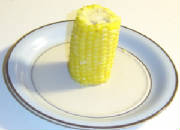
COOKING HINT:
Put a section of corncob vertically on a plate, then microwave
it. When it's about half cooked, turn the cob over onto the other end. My microwave cooks frozen cobs perfectly
this way just by pressing "frozen vegetable." In order not to lose perfectly good corn by having him drop a half-finished
piece onto you-know-what, I cut the cob into smaller pieces for Ziggy.
CLICK FOR ZIGGY'S OPINION OF CORN
|
 |
|
|
|
 |
|



